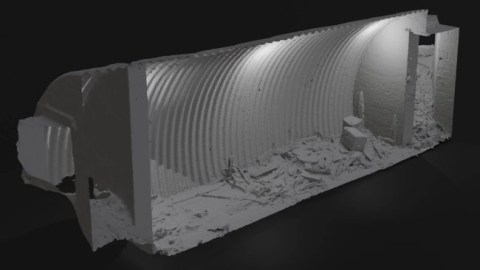Secret bunker from WWII found in Scotland

Image: © FLS/AOC Archaeology
- Scottish foresters have recently stumbled on a hidden bunker dating back to WWII.
- It is one of hundreds of bunkers designed to hide a secret guerrilla army in the event of a German invasion.
- For the sake of protecting the site, its precise location will not be made public.
A secret bunker built as part of a plan to wreak havoc on any Nazi invaders of the United Kingdom was recently rediscovered by a forestry crew in the Scottish border region. A 7-meter long by 3-meter wide (23 feet by 10 feet) tube made of tin, brick, and concrete, the bunker would have housed seven members of “Churchill’s Secret Army” for months, or even years.
Forestry and Land Scotland, a government agency, stumbled upon the bunker while felling trees in the Craigielands Forest near Moffat. Hidden behind a large iron door in an overgrown trench, its discovery helps shed light on a dark period of British history.
The bunker was found mostly empty, save for an empty tin can and broken pieces of what may have once been a wooden bed. It would once have held bunks, ammunition, supplies for two weeks, and a portable toilet. It, like several hundred others like it, would have also had two hidden entrances.
People often forget exactly how bad things looked for the Allies in 1940. France and the low countries had fallen inside of six weeks. Before that, Denmark and Norway lasted a day against the German army. While we tend to remember the soaring rhetoric of Churchill declaring that the English would never surrender, George Orwell tells us that at the time of that speech, a defeatist attitude was prevailing among the people which words did only so much to subdue.
While a German invasion of the UK would have probably gone rather poorly, the consensus remains that the German fleet could not stop the Royal Navy from annihilating an invasion flotilla no matter how the Battle of Britain turned out. The risk of it was significant enough for Churchill to order the creation of an auxiliary army of three and a half thousand men to carry out sabotage in the event of a successful Nazi invasion.
The auxiliary units were a secret force; each member was supposed to sign an oath of secrecy, who were even unknown to the leaders of local home-guard units. In the event of German occupation, the guards were to launch a brutal guerrilla campaign against the Nazis while based out of the hidden bunkers mentioned above.
They would have been autonomous units raiding areas they knew by heart at night, blowing up fuel and supply dumps, tearing up roads, assassinating German officers and British collaborators, and causing as much useful mayhem behind the lines as possible. Some groups had sealed orders with the names of local officials who knew of their existence, if an assassination for the sake of security was needed.
If at risk of capture, they were expected to kill themselves and any of their comrades at similar risk. It is little wonder why these scallywags, as they were also called, had a life expectancy of two weeks in the event of invasion. Those two weeks would have primarily been spent hiding in one of several hundred bunkers similar to the one just rediscovered, waiting for the fascist menace to pass over their hiding space, emerging only to launch vicious raids before fleeing back to the safety of the bunker.
Of course, the invasion never came. The Auxiliaries were kept on in their unique role until 1944 when things looked a bit better for the Allies. They served at D-Day and in the liberation of Western Europe as special forces. Their service remained secret for decades, and it was not until 2013 that the tremendous sacrifice that they were willing to make was officially recognized.
Fittingly, the exact location of the newly found bunker will remain a secret.





